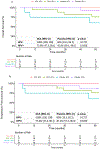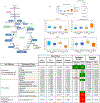Phase II study of dichloroacetate, an inhibitor of pyruvate dehydrogenase, in combination with chemoradiotherapy for unresected, locally advanced head and neck squamous cell carcinoma
- PMID: 35312941
- PMCID: PMC9106928
- DOI: 10.1007/s10637-022-01235-5
Phase II study of dichloroacetate, an inhibitor of pyruvate dehydrogenase, in combination with chemoradiotherapy for unresected, locally advanced head and neck squamous cell carcinoma
Abstract
Chemoradiotherapy (CRT) for locally-advanced head and neck squamous cell carcinoma (LA-HSNCC) yields 5-year survival rates near 50% despite causing significant toxicity. Dichloroacetate (DCA), a pyruvate dehydrogenase kinase metabolic inhibitor, reduces tumor lactate production and has been used in cancer therapy previously. The safety of adding this agent to CRT is unknown. Our randomized, placebo-controlled, double-blind phase II study added DCA to cisplatin-based CRT in patients with LA-HNSCC. The primary endpoint was safety by adverse events (AEs). Secondary endpoints compared efficacy via 3-month end-of-treatment response, 5-year progression-free and overall survival. Translational research evaluated pharmacodynamics of serum metabolite response. 45 participants (21 DCA, 24 Placebo) were enrolled from May 2011-April 2014. Higher rates of all-grade drug related fevers (43% vs 8%, p = 0.01) and decreased platelet count (67% vs 33%, p = 0.02) were seen in DCA versus placebo. However, there were no significant differences in grade 3/4 AE rates. Treatment compliance to DCA/placebo, radiation therapy, and cisplatin showed no significant difference between groups. While end-of-treatment complete response rates were significantly higher in the DCA group compared to placebo (71.4% vs 37.5%, p = 0.0362), survival outcomes were not significantly different between groups. Treatment to baseline metabolites demonstrated a significant drop in pyruvate (0.47, p < 0.005) and lactate (0.61, p < 0.005) in the DCA group. Adding DCA to cisplatin-based CRT appears safe with no detrimental effect on survival and expected metabolite changes compared to placebo. This supports further investigation into combining metabolic agents to CRT. Trial registration number: NCT01386632, Date of Registration: July 1, 2011.
Keywords: Chemoradiotherapy; Dichloroacetate; Head and neck cancer; Tumor microenvironment.
© 2022. The Author(s), under exclusive licence to Springer Science+Business Media, LLC, part of Springer Nature.
Conflict of interest statement
Figures



References
-
- Forastiere AA, Goepfert H, Maor M, Pajak TF, Weber R, Morrison W, Glisson B, Trotti A, Ridge JA, Chao C, Peters G, Lee D-J, Leaf A, Ensley J, Cooper J: Concurrent Chemotherapy and Radiotherapy for Organ Preservation in Advanced Laryngeal Cancer. N. Engl. J. Med 349, 2091–2098 (2003). 10.1056/NEJMoa031317 - DOI - PubMed
-
- Adelstein DJ, Li Y, Adams GL, Wagner H, Kish JA, Ensley JF, Schuller DE, Forastiere AA: An Intergroup Phase III Comparison of Standard Radiation Therapy and Two Schedules of Concurrent Chemoradiotherapy in Patients With Unresectable Squamous Cell Head and Neck Cancer. J. Clin. Oncol 21, 92–98 (2003). 10.1200/JCO.2003.01.008 - DOI - PubMed
-
- Forastiere AA, Zhang Q, Weber RS, Maor MH, Goepfert H, Pajak TF, Morrison W, Glisson B, Trotti A, Ridge JA, Thorstad W, Wagner H, Ensley JF, Cooper JS: Long-Term Results of RTOG 91-11: A Comparison of Three Nonsurgical Treatment Strategies to Preserve the Larynx in Patients With Locally Advanced Larynx Cancer. J. Clin. Oncol 8 (2013) - PMC - PubMed
-
- Ang KK, Zhang Q, Rosenthal DI, Nguyen-Tan PF, Sherman EJ, Weber RS, Galvin JM, Bonner JA, Harris J, El-Naggar AK, Gillison ML, Jordan RC, Konski AA, Thorstad WL, Trotti A, Beitler JJ, Garden AS, Spanos WJ, Yom SS, Axelrod RS: Randomized Phase III Trial of Concurrent Accelerated Radiation Plus Cisplatin With or Without Cetuximab for Stage III to IV Head and Neck Carcinoma: RTOG 0522. J. Clin. Oncol 32, 2940–2950 (2014). 10.1200/JCO.2013.53.5633 - DOI - PMC - PubMed
Publication types
MeSH terms
Substances
Associated data
Grants and funding
LinkOut - more resources
Full Text Sources
Medical
Research Materials
Miscellaneous

